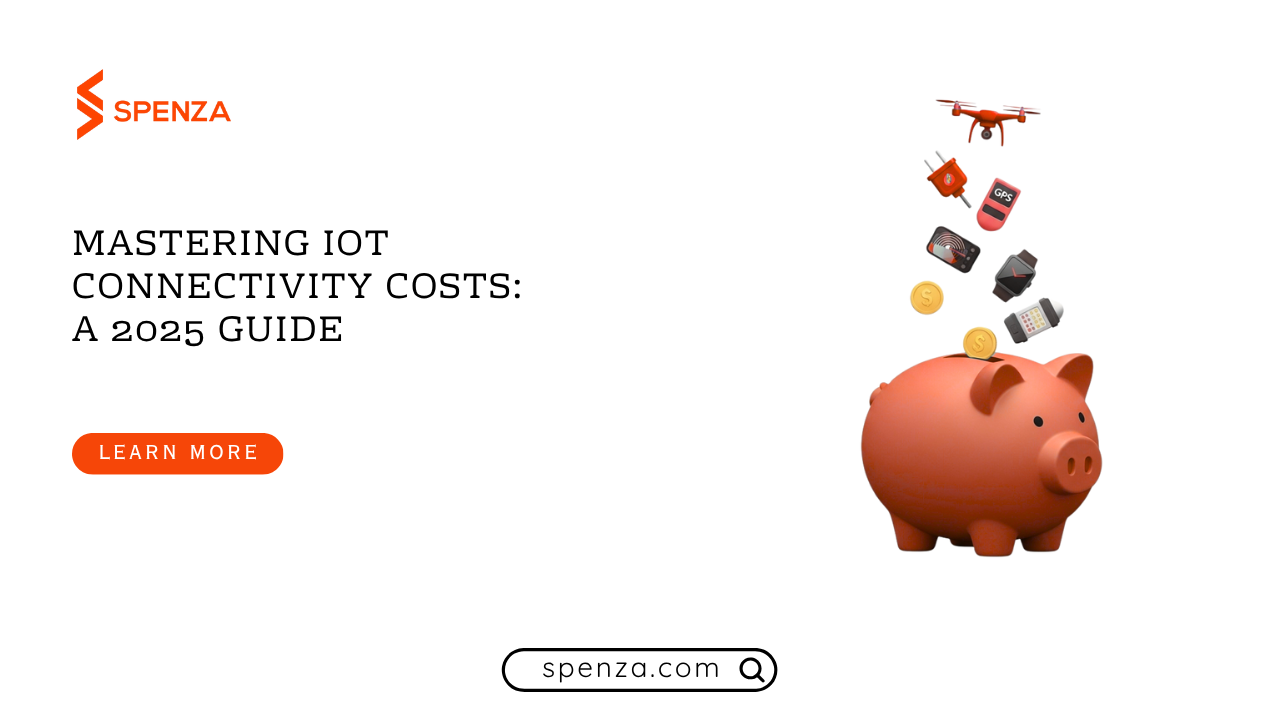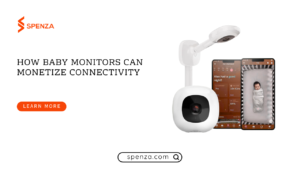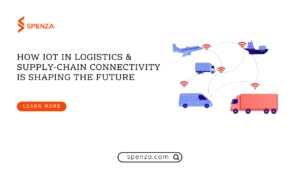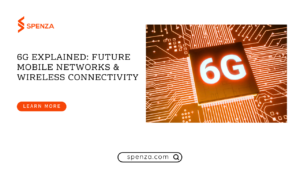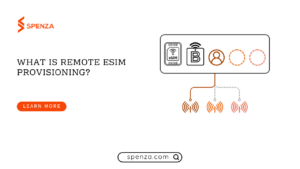Table of Contents
- Introduction
- Understanding the Full Spectrum of IoT Connectivity Costs
- SIM, eSIM, and iSIM Hardware Costs
- Monthly SIM Access and Platform Fees
- Data Usage: Per-MB vs Tiered vs Pooled Pricing
- Network and Coverage Costs by Region
- Overages, Roaming, and Unexpected Charges
- Network Sunset and SIM Lifecycle Risk
- Connectivity Type Cost Breakdown
- Multi-Country IoT Deployments: The Cost Reality
- The Three Biggest Multi-Country Cost Drivers
- Why Global IoT Connectivity Is a Balancing Act
- Four Practical Strategies for IoT Cost Optimization Across Borders
- Design for Network Flexibility
- Implement Centralized SIM Lifecycle Management
- Use Pooled and Tiered Plans Regionally
- Automate Roaming Cost Control
- The Role of a Unified Connectivity Platform in Cost Control
- Spenza in Practice: Enabling True Global IoT Connectivity
- Conclusion: Turn Your Biggest Cost Center into a Competitive Edge
- FAQs
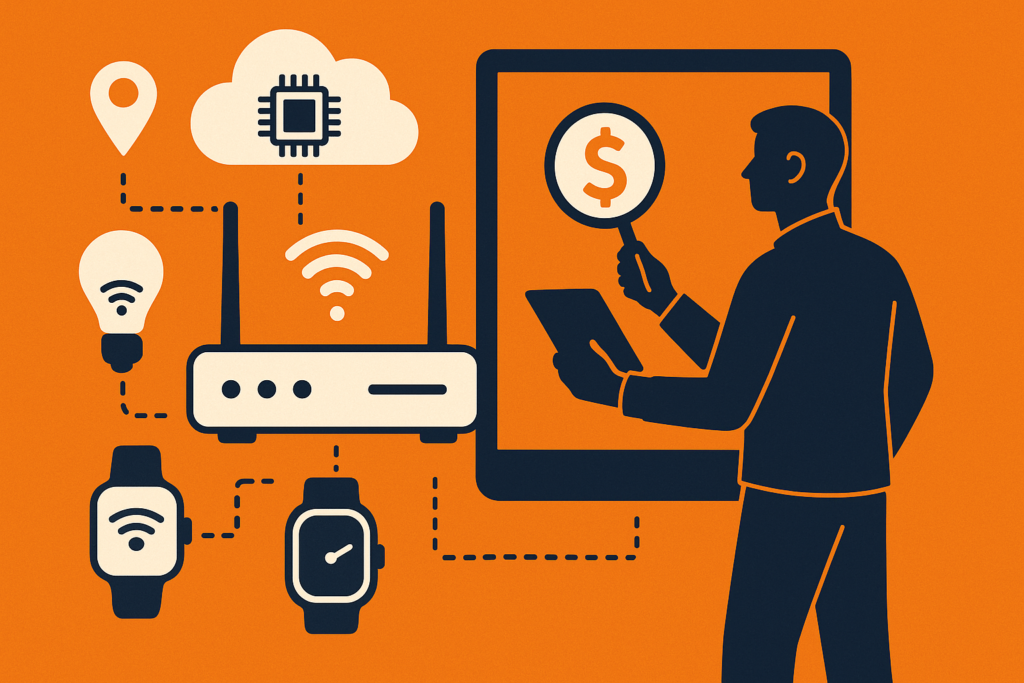
Introduction
What if the biggest hit to your profit this year isn’t from manufacturing, supply chain delays, or marketing but from the silent rise of IoT connectivity costs you barely see coming?
In 2025, a U.S. asset tracker using 10 MB per month can cost as little as $0.37/month with an optimized IoT MVNO plan, and as much as $5 or more on a standard MNO plan. European utility meters using NB-IoT might cost less than €3/year.
These numbers highlight massive variance, and the urgent need for smart IoT cost optimization, especially in multi-country IoT rollouts where roaming, local regs, and data pools complicate everything.
The smartest teams now use a unified connectivity platform to centralize provisioning, manage SIM lifecycles, and apply cost controls across borders. Spenza, for example, enables this with real-time usage analytics, integrated SIM/eSIM provisioning, and carrier management tools built for IoT connectivity.
Keep reading to see exactly how these costs stack up, where the hidden charges hide, and what steps smart manufacturers are taking to turn IoT connectivity costs into a predictable, controlled part of their business.
What Would You Get by the End of the Article?
- Clarity on what makes up IoT connectivity costs, beyond just the data plan.
- Insight into module costs, SIM and eSIM rates, per-MB fees, and comparisons across U.S., EU, China.
- Understanding of how different networks (NB-IoT, LTE-M, Cat-1, LTE/5G, LoRaWAN, satellite) translate into cost for use case.
- A clear framework to approach telecom expense management IoT with proactive planning.
- An expert perspective on why a unified connectivity platform changes the game for IoT cost optimization.
- Confidence in managing global IoT connectivity with minimized surprises and smarter control.
Understanding the Full Spectrum of IoT Connectivity Costs
The total bill for connecting a device goes far beyond the monthly data plan. Hardware, provisioning, platform access, roaming, and even regulatory compliance all feed into the real cost. Understanding each piece lets you spot waste early and plan for efficiency from day one.
1. SIM, eSIM, and iSIM Hardware Costs
A physical rugged IoT SIM can cost $2–$3 each in volume. Standard plastic SIMs run around $1–$2. In contrast, eSIM chips cost below $0.70 at scale, and iSIM even less when integrated into the system-on-chip.
This matters because an upfront $2 SIM cost amortized over 10 years adds roughly $0.17/year. Lowering that via eSIM means immediate savings, and it enables remote carrier switching, major for IoT cost optimization.
eSIM also reduces logistics costs. No more stacking SIM bins or risking mis-shipping. That saves labor. A unified connectivity platform can handle eSIM provisioning dynamically. For example, Spenza lets you push SIM profiles over the air through API endpoints, cutting time and cost from provisioning workflows, even across 190+ countries.
2. Monthly SIM Access and Platform Fees
A typical MNO might charge $2–$3 per SIM per month, even with zero usage. Many IoT-focused carriers include SIM management, analytics, and dashboards in their package but still charge a nominal fee, say, $0.20–$0.50 per month per SIM.
A 1,000-unit deployment paying $0.50/month each equals $500/month or $6,000/year in fixed charges. With telecom expense management IoT, these fixed fees must be tracked and reduced where possible.
Using a unified portal, you can group SIMs by project or region, apply bulk rules, and cancel inactive devices immediately. You eliminate unnecessary spending, exactly the kind of control described in Spenza’s telecom expense management system for business mobile services pricing.
3. Data Usage: Per-MB vs Tiered vs Pooled Pricing
Small bucket plans cost $0.05–$0.10 per MB for say 10–100 MB/month. Mid-tier plans (100–500 MB) can drop to $0.03–$0.05 per MB. High-volume users (GBs per month) often pay under $0.01 per MB with pooled plans.
Examples:
- Telnyx in the U.S. charges ~$0.078/MB for ≤100 MB, $0.039/MB for 100–500 MB, and $0.0125/MB for >5 GB.
- An asset tracker using 10 MB charges could pay ~$0.78 in raw data plus access fees, or $1/month if optimized. But with tiered volume, that might drop to $0.50 or less.
Pooling across devices helps. If 1,000 devices share a 100 GB pool, each gets 100 MB/month with lower marginal cost. This pooled structure spreads bursts evenly, something explained in Spenza’s guide on choosing IoT connectivity plans.
4. Network and Coverage Costs by Region
U.S.: LTE-M is widespread; NB-IoT is being phased out (e.g. AT&T shutting NB-IoT in 2025). You rely on LTE-M, Cat-1, or LoRaWAN. MNO SIMs cost more; MVNO plans are cheaper. A 100 MB SIM on Verizon could exceed $10/month, while an IoT MVNO might offer $0.73/month with usage+fee breakdown.
EU: NB-IoT and LTE-M coexist widely. Utility deployment NB-IoT can run under €3/year per meter in large tenders. LoRaWAN private networks offer zero recurring fees. Roam-like-at-home laws ease multi-country coverage for consumer data, but IoT SIMs may be exempt. Still, roaming often costs less in large region-wide plans.
China: Massive NB-IoT scale drives module and connectivity costs to ~$1/device/year or less.
These regional gaps translate directly into global IoT connectivity pricing complexity. They also highlight the importance of using a telecom expense management IoT approach to handle variations.
5. Overages, Roaming, and Unexpected Charges
A single firmware bug could send 1 GB instead of 10 MB. At $0.01/MB that’s $10, unexpected when expected cost was $0.10. Worse, if your plan charges $1.50/MB in overage, that’s $1,500 extra.
Roaming can double or triple per-MB rates unless you use local profiles or roaming-friendly SIMs. Without safeguards, you get billed for what feels like daylight robbery.
A unified platform flags usage spikes and auto-triggers caps or alerts, core to Spenza’s telecom expense management implementation.
6. Network Sunset and SIM Lifecycle Risk
2G and 3G are off in the U.S. already. Europe is sunsetting 3G, and utility devices still on 2G in other regions face forced upgrades. That means replacing modems or SIMs mid-deployment.
Planning for flexibility saves cost. If your module supports LTE-M, Cat-1, and eSIM, you can adapt to new networks without field swaps. That foresight prevents huge mid-deployment charges and ensures your IoT connectivity costs stay predictable.
Connectivity Type Cost Breakdown
Different IoT networks come with very different cost structures. Some are almost free to run once deployed, while others carry high recurring charges but deliver speed and bandwidth that certain use cases demand.
The table below compares common network types so you can see how they stack up in both upfront and ongoing cost.
| Network Type | Module Cost | Typical Plan Cost (U.S.) | Best Use Case | Cost Insight |
|---|---|---|---|---|
| NB-IoT | $5–$20 | $1–$5/year | Static sensors, meters | Lowest recurring cost; limited in U.S. |
| LTE-M (Cat-M1) | $6–$25 | $1–$3/month | Mobile trackers, wearables | Good balance of power and mobility |
| LTE Cat-1 / Cat-1bis | $8–$30 | $2–$5/month | Mid-data IoT devices | Future-proof fallback as 3G dies |
| LTE / 5G | $10–$40 | $5–$10+/month | Video, high-data IoT | High cost, high speed |
| LoRaWAN (private) | $8–$12/module | $0 after infrastructure | Campus, industrial IoT | Very low recurring cost if you own gateway |
| Satellite IoT | $20+ module | $5–$25/month | Remote/off-grid devices | Use only when nothing else works; still high per-byte cost |
You see how IoT connectivity costs vary enormously by network, region, and use case. A tracker might cost you $0.37/month or $5/month, depending on plan. A utility meter might cost ~$3/year or tens of dollars, depending on the provider. These differences scale rapidly with volume.
When you calculate ROI or Total Cost of Ownership for devices, you must include full connectivity breakdown. If you don’t, your profit estimates fall apart. In 2025, analysts estimate the average IoT ARPU to be only a few euros per device annually. Between 2024–2029, revenue from cellular IoT climbs from €14.2B to €22.4B while devices increase from 3.8B to 6.4B, yielding per-device revenue of ~€3.50/year on average. Every cent saved counts.
The answer is proactive, continuous telecom expense management IoT backed by a unified connectivity platform. That’s what Part 2 will cover, how to control spend globally, manage multi-country deployments without budget bleed, and optimize across every lever.
Multi-Country IoT Deployments: The Cost Reality
When your IoT devices ship into multiple regions, the IoT connectivity costs equation changes fast.
Even if each market has low-cost options locally, deploying without coordination multiplies complexity. Costs creep in through roaming surcharges, local compliance fees, SIM imports, and unoptimized plans.
For example, a U.S.-based fleet tracking company shipped 5,000 LTE-M trackers into Europe without pre-arranged regional plans. The result? Average cost per tracker jumped from $1.20/month to over $4/month in just two billing cycles. The increase came from permanent roaming fees in France and Germany, plus higher per-MB rates in Eastern Europe.
The Three Biggest Multi-Country Cost Drivers

- Permanent Roaming Restrictions
Countries like Brazil and India ban foreign SIMs after a period, often 90–180 days. If your devices rely on a U.S.-based SIM in those markets, they get cut off, forcing emergency local provisioning. That emergency switch is expensive. Using eSIM to load a local profile from a unified connectivity platform avoids this. - SIM Import Taxes and Local Compliance
Some regions treat SIM cards as telecom equipment with import duties. These can add 5–15% to hardware cost if you ship physical SIMs. With eSIM or iSIM, you remove that import cost completely. This is a core point in Spenza’s telecom expense management implementation guide. - Roaming Tariffs vs. Localized Profiles
Roaming charges can be double or triple domestic rates. A $0.01/MB domestic plan might become $0.03/MB or more abroad. If a device uses 200 MB, that’s $6 instead of $2 per month. This difference scales quickly in multi-country IoT deployments.
Why Global IoT Connectivity Is a Balancing Act
Manufacturers face a strategic choice:
- One global SIM / plan: Simple but can mean higher rates in certain regions.
- Multiple local SIMs: Lower local rates but high operational complexity.
- eSIM-based unified profile management: Flexibility to load the cheapest local plan remotely, keeping operations and cost balanced.
This is why global IoT connectivity is rarely about the lowest headline price in one country, it’s about the total, blended cost across your footprint.
When done right, global optimization can drop average per-device cost by 20–30% compared to unmanaged regional contracts. That is exactly the scale of improvement shown in Spenza’s telecom expense management system for business mobile services pricing.
Four Practical Strategies for IoT Cost Optimization Across Borders
Once you understand the cost drivers, the next step is taking action. Effective IoT cost optimization means aligning technology, contracts, and management tools so they work together.
The strategies below show how leading manufacturers keep control even when operating across multiple countries.

1. Design for Network Flexibility
Choose modules that support multiple bands and standards, like LTE-M, Cat-1bis, and NB-IoT, plus eSIM/iSIM. This ensures your devices can switch to the cheapest IoT data plans available in each market.
Example: A European smart metering project saved €2.5M over 10 years by switching from a single-operator NB-IoT contract to a mixed NB-IoT/LTE-M plan via eSIM provisioning. The switch was triggered automatically when a country’s rates changed.
2. Implement Centralized SIM Lifecycle Management
Inactive SIMs are silent profit leaks. A global deployment of 50,000 devices might have 3–5% inactive units at any time. At $1.50/month, that’s $27,000–$37,500/year wasted.
A unified connectivity platform lets you set rules: suspend a SIM if unused for 30 days, auto-reactivate when needed. This policy alone can cut fixed IoT connectivity costs by a measurable percentage.
3. Use Pooled and Tiered Plans Regionally
Pooling reduces waste where usage is uneven. In North America, pooling might lower per-device data cost to under $0.01/MB. In Asia-Pacific, tiered pricing could make more sense due to consistent usage patterns.
By splitting regions by usage model, you avoid overpaying in high-use geographies or wasting in low-use ones.
4. Automate Roaming Cost Control
Set thresholds: if roaming usage exceeds 10 MB/day, switch to a local profile. Spenza’s IoT connectivity management platform can trigger this automatically, applying a local carrier eSIM profile and cutting per-MB cost by more than half.
The Role of a Unified Connectivity Platform in Cost Control
Without centralized oversight, you can’t see your total IoT connectivity costs, let alone control them. A unified connectivity platform solves this by:
- Consolidating multiple carrier contracts in one interface.
- Tracking real-time usage at the SIM and account level.
- Enforcing cost rules (caps, suspensions, alerts) globally.
- Automating provisioning and profile swaps across multi-country IoT rollouts.
This approach supports true telecom expense management IoT, turning cost control from a quarterly spreadsheet task into a live operational process.
Spenza in Practice: Enabling True Global IoT Connectivity
Spenza’s platform integrates:
- SIM and eSIM provisioning through APIs.
- Carrier management tools for 190+ countries.
- Customizable billing engines to match your accounting model.
- Usage analytics tied directly to cost per device.
For a manufacturer, this means you can:
- Launch devices in multiple markets with predictable rates.
- Shift to cheaper regional profiles instantly.
- Prove cost savings with hard data from the platform.
By combining IoT cost optimization with operational simplicity, Spenza’s model addresses both CFO concerns and engineering needs, without compromising rollout speed.
Conclusion: Turn Your Biggest Cost Center into a Competitive Edge
Uncontrolled IoT connectivity costs drain profit. Managed correctly, they give you a long-term advantage. In 2025’s tight-margin environment, IoT cost optimization is as critical as product design. The technology exists to make it happen, and Spenza delivers it.
FAQs
Add the SIM or eSIM hardware cost, monthly access fee, average monthly data usage cost, expected roaming charges, and any platform fees. Multiply by the expected device lifespan. This total shows the true per-device cost you must manage.
Yes. Many providers offer pooled data plans, where all devices draw from a single data bucket. This reduces waste from underused plans and is especially useful in global IoT connectivity where usage patterns vary by market.
The biggest risk is cost sprawl, paying different rates without visibility, incurring hidden roaming fees, and losing control over inactive SIMs. A unified platform centralizes control and prevents these issues.
By identifying unused SIMs, enforcing data caps, switching to lower-cost carriers, and consolidating billing, companies reduce spend by 20–30%. That directly improves margins without changing product pricing.
Yes. eSIMs follow GSMA security standards and often improve security over physical SIMs, which can be stolen or swapped. Plus, remote provisioning avoids physical handling risks in multi-country deployments.
Ready to gain complete control over your global IoT connectivity costs? Contact Spenza for a demo of our unified management platform.

